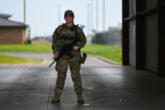August 29, 2021
Ignoring the National Guard is dangerous
At the last minute, Congress recently approved a funding plan to reimburse the National Guard Bureau for $500 million in expenses incurred while securing Washington following the Jan. 6 attack on the U.S. Capitol. Without the congressional deal, the Guard was at risk of a funding collapse. While this budget crisis put the problems facing the National Guard in stark relief, it is not the first challenge the Guard has faced in recent years.
On the heels of an Aug. 19 Capitol Hill bomb threat, an upcoming “Justice for J6” demonstration has prompted a complete activation of the D.C. police department. Given ongoing security concerns around the Capitol, the discussion around the potential role of the National Guard in an emergency situation is as urgent as ever. To avoid a national security emergency, policymakers in both the legislative and executive branches need to reassess how, when and why the Guard is utilized from both operational and readiness perspectives. The current path appears to be unsustainable.
The reliance on the National Guard to fulfill wartime personnel demands marks a transition from a strategic reserve to an operational reserve, in which the Guard meets similar requirements to active-duty troops without the necessary resources.
The Department of Defense (DOD) has relied on the Guard’s support for decades, placing great stress on the institution. Since 9/11, more guard units have been deployed overseas than at any time since World War II, indicating an enormous shift in the way the Guard is used. The reliance on the National Guard to fulfill wartime personnel demands marks a transition from a strategic reserve to an operational reserve, in which the Guard meets similar requirements to active-duty troops without the necessary resources. The past two years, though, have put a spotlight on the wide range of circumstances under which the Guard is called to serve: state missions, COVID-19 missions, missions at the southern border, securing the U.S. Capitol, and the presidential inauguration, as well as overseas missions.
Throughout 2020, the National Guard responded to a series of wildfires and civil unrest as they occurred across the country, while at the same time supporting the COVID-19 mission through testing, food banks, vaccinations and logistics. In 2020, the National Guard reported 11 million “man days,” compared to 2 million in 2019 — a 450 percent increase.
Read the full article from The Hill.
More from CNAS
-
Pete Hegseth’s Views About Women and Military Standards
In recent weeks, Hegseth walked back comments made while promoting his book, where he said women did not belong in ground combat units. Without citing specific examples, he co...
By Katherine L. Kuzminski
-
Sharper: Trump's First 100 Days
Donald Trump takes office in a complex and volatile global environment. Rising tensions with China, the continued war in Ukraine, and instability in the Middle East all pose s...
By Charles Horn
-
Tackle the Military Recruiting Crisis
The Trump administration should drive a whole-of-government approach to address the military recruiting crisis and ensure that the nation has the quality force necessary to de...
By Katherine L. Kuzminski
-
What Trump’s Pick for Secretary of Defense Could Mean for Inclusivity in the Military
Dr. Kyleanne Hunter, Adjunct Senior Fellow with the Military, Veterans, and Society Program at CNAS joins to discuss the Trump administration nominee for secretary of defense....
By Dr. Kyleanne Hunter




